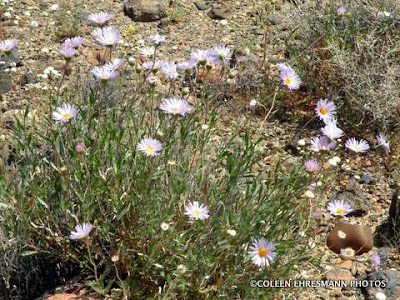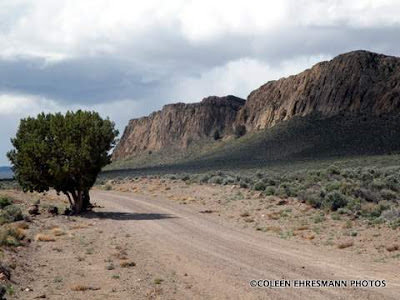We traveled and geocached the ET Highway in October 2013 after meeting fellow geocachers Clay & Gus from Las Vegas. These two young guys dreamed up the idea of placing geocaches along NV state highway 375 as it is about 100 miles of very boring road. Check out those two blog posts.
The Middle of No Where ~ Rachel NV and
Geocaching the ET Highway
Completing the caches along the ET Highway is a goal of Hubby. I agreed to 3 days in Tonopah NV (not Rachel...once was enough) on our way back to SD this trip. In October 2013 there were 1500 Clay & Gus geocaches. The total now is 2400 of theirs and another 1000 by other people. We did about 550 in 2013. Read the blog to see what our total was this trip.
Day 1, April 13th
we spent most of the day caching along 2 highways, 6 & 375
snow capped mountains in the distance
mule deer? antelope?
typical hides of the geocaches
small film canister or pill bottle in a pile of rocks
every 526' ~ 10 in a mile
3 highway patrol cars
WTH?
large piece of equipment on the road
very large piece of equipment
That was the excitement for Day 1 between Rachel and Tonopah. Oh, and a record number of geocaches collected by the two of us ~ 425. (Previous record 326) We didn't even work that hard on Day 1. We broke the old record, that is all that mattered.
Day 2, April 14th
no highway geocaching today
sometimes it is more important to know where you have been
somebody spent a lot of time and patience building this cairn
and this is what is ahead of us
more snow capped mountains
I apologize for the extra appendage
I didn't place it or realize it was there
(hey, there's not a lot to do for entertainment in this area!)
the horse sign and one for cattle are placed along
the 110 miles of road/highway
cattle are often grazing along the highway
no fences ~ this is open range country
I saw some horses on Day 1, but Hubby didn't think they
were wild horses
we saw several on this day & close enough to get photos
Hubby did his horse 'neigh' imitation and got their attention
in fact this Big Boy started coming to the van
Hubby got back inside...after getting the cache
and allowing me to get some good photos
then just a bit farther down the road some cows were
grazing and drinking
this one posed with being 'called'
and some more horses
one also was listening to Hubby's horse call
maybe another stallion?????
Seeing the wild horses at such a close range made my day! There are some great perks to caching back in the mountains, away from the highway.
Day 3, April 15th
fog? rain?
windy or windy??? short i or long i???
it is coming closer!
snow pellets/sleet
interesting mountains to the west all day
the road moved around the tree
we stopped in Rachel for lunch
and some souvenir shopping
town hasn't grown since 2013
same tourist attractions
celebrating 13,000 caches
and 12,000 caches
we reached these goals somewhere along the ET Highway
and the 1450 caches we found and signed
didn't see any signs for Area 51
this building says it is the research center
I don't think so!
So now we concentrate on getting back to SD. Geocaching will be incidental. Watching the weather will take center stage.








































































